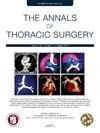纵隔大肿块的麻醉风险:基于系统综述的管理框架。
IF 3.6
2区 医学
Q1 CARDIAC & CARDIOVASCULAR SYSTEMS
引用次数: 0
摘要
背景:对纵隔有巨大肿块的患者实施麻醉可能会引发灾难性的急性血流动力学或呼吸系统失代偿。需要对现有证据进行审查,以确定风险程度、机制以及减轻风险的预防性或反应性干预措施:方法:我们对 PubMed 数据库中涉及成人纵隔大肿块患者接受手术或麻醉的研究进行了系统性综述;纳入了所有类型的出版物,这些出版物提供了有关风险、机制或解决潜在失代偿的技术的数据。这些文献主要涉及病例报告和小型回顾性系列研究;未进行适当的质量评估。根据编写小组的一致判断对证据进行了综合:根据症状程度、肿块/胸廓比例以及气道和/或血管受压程度,对纳入的 72 项研究进行了审查,得出了低、中、高和极高风险类别。这简化了所需的准备工作--低风险的准备工作最少,高风险的准备工作更多。评估解剖压迫对个别患者生理失调的影响可为麻醉管理提供一个框架,并在出现失代偿时提供备用计划:尽管涉及不常见但严重事件的课题在证据方面存在局限性,但我们还是制定了一个框架,以合理的方式简化了需要麻醉的巨大纵隔肿块患者的准备和管理。本文章由计算机程序翻译,如有差异,请以英文原文为准。
Anesthetic Risk with Large Mediastinal Masses: A Management Framework Based on a Systematic Review
Background
Anesthesia administered to a patient with a large mediastinal mass engenders concern that it may precipitate catastrophic acute hemodynamic or respiratory decompensation. A review of the available evidence is needed to define the degree of risk, mechanisms, and preventative or reactive interventions to mitigate the risk.
Methods
A systematic review of the PubMed database was conducted of studies involving adults with large mediastinal masses undergoing a procedure or anesthesia; all types of publications were included that provided data regarding risks, mechanisms, or techniques to address potential decompensation. This literature involves primarily case reports and small retrospective series; no quality assessment was deemed appropriate. Evidence was synthesized according to the consensus judgment of the writing panel.
Results
Categories of low-, moderate-, high-, and very-high-risk emerged from review of the 72 included studies, based on the degree of symptoms, mass/chest ratio, and degree of airway and/or vascular compression. This streamlines the preparation needed—minimal for low-risk and more extensive for higher-risk. Assessment of the impact of physiologic derangement stemming from the anatomic compression in individual patients provides a framework for anesthetic management, and back-up plans should decompensation occur.
Conclusions
Despite limitations in the evidence inherent to a topic involving an uncommon but serious event, a framework was developed to streamline preparation for and management of patients with a large mediastinal mass requiring anesthesia in a rational manner.
求助全文
通过发布文献求助,成功后即可免费获取论文全文。
去求助
来源期刊

Annals of Thoracic Surgery
医学-呼吸系统
CiteScore
6.40
自引率
13.00%
发文量
1235
审稿时长
42 days
期刊介绍:
The mission of The Annals of Thoracic Surgery is to promote scholarship in cardiothoracic surgery patient care, clinical practice, research, education, and policy. As the official journal of two of the largest American associations in its specialty, this leading monthly enjoys outstanding editorial leadership and maintains rigorous selection standards.
The Annals of Thoracic Surgery features:
• Full-length original articles on clinical advances, current surgical methods, and controversial topics and techniques
• New Technology articles
• Case reports
• "How-to-do-it" features
• Reviews of current literature
• Supplements on symposia
• Commentary pieces and correspondence
• CME
• Online-only case reports, "how-to-do-its", and images in cardiothoracic surgery.
An authoritative, clinically oriented, comprehensive resource, The Annals of Thoracic Surgery is committed to providing a place for all thoracic surgeons to relate experiences which will help improve patient care.
 求助内容:
求助内容: 应助结果提醒方式:
应助结果提醒方式:


